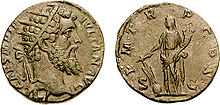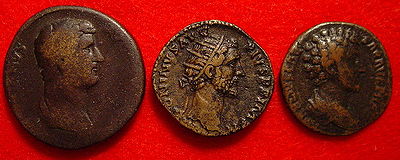- Dupondius
-
The dupondius (Latin two-pounder) was a brass coin used during the Roman Empire and Roman Republic valued at 2 asses (1/2 of a sestertius or 1/8 of a denarius).
The dupondius was introduced during the Roman Republic as a large cast coin, although even at introduction it weighed less than 2 pounds. The coin featured the bust of Roma on the obverse and a six-spoked wheel on the reverse. This denomination was not minted during the Republican Era.
 Didius Julianus, 193 AD
Didius Julianus, 193 AD
With the coinage reform of Augustus in or about 23 BC, the sestertius and dupondius were produced in a golden colored copper-alloy called orichalcum by the Romans and numismatists, and by us brass, while lower denominations were produced out of reddish copper. However, some dupondi were made from copper under Augustus, while under Nero some of the as denomination were made from orichalcum instead of copper. The latter can only be distinguished by their smaller size and the metal.
The dupondius was normally further distinguished from the similarly sized as with the addition of a radiate crown to the bust of the emperor in 66 AD during the reign of Nero. Using a radiate crown to indicate double value was also used on the antoninianus (double denarius) and double sestertius. Since dupondii minted prior to and during the reign of Nero, and occasionally under later rulers, lack the radiate crown, it is often hard to distinguish between the as and the dupondius due to heavy patination which obscures the coin's original color.
An extremely rare dupondius from the reign of Marcus Aurelius, dated to AD 154 or 155 and in excellent condition, was discovered in 2007 at the archeological site in Draper's Gardens, London.
 Dupondius of Vespasian (AD 69-79), struck at Lyon in about AD72-73. This coin has escaped serious corrosion and thus retains its original appearance and colour, showing why the Romans sometimes also called orichalcum aurichalcum from aurum for gold. The coin is 29mm in diameter.
Dupondius of Vespasian (AD 69-79), struck at Lyon in about AD72-73. This coin has escaped serious corrosion and thus retains its original appearance and colour, showing why the Romans sometimes also called orichalcum aurichalcum from aurum for gold. The coin is 29mm in diameter.
See also: Roman currency.
External links
Categories:- Coins of ancient Rome
- Numismatics
Wikimedia Foundation. 2010.


